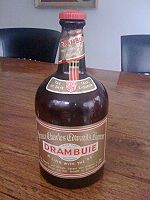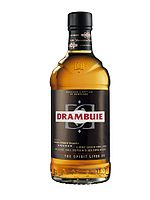- Drambuie
-
Coordinates: 55°56′19.49″N 3°26′36.54″W / 55.9387472°N 3.4434833°W
Drambuie (
 /dræmˈbjuːi/ or /dræmˈbuːi/) is a sweet, golden colored 80-proof liqueur made from malt whisky, honey, herbs, and spices.
/dræmˈbjuːi/ or /dræmˈbuːi/) is a sweet, golden colored 80-proof liqueur made from malt whisky, honey, herbs, and spices.Produced in Broxburn, West Lothian, Scotland, it is served straight, on the rocks, or added to mixed drinks such as the Rusty Nail.
In 2009, Drambuie launched The Royal Legacy of 1745, an upscale malt whisky liqueur. The 46% alcohol by volume spirit won the Drinks International Travel Retail Award for Best Travel Retail Drinks Launch at the TFWA, Cannes in October 2009.[1]
Contents
Etymology
The name "Drambuie" may derive from the Scottish Gaelic phrase an dram buidheach, meaning "the drink that satisfies", or possibly an dram buidhe meaning "the yellow drink".[2]
History
After the Battle of Culloden in 1746, Prince Charles Edward Stuart fled to the island of Skye. There, he was given sanctuary by Captain John MacKinnon of Clan MacKinnon. According to family legend, after staying with the captain, the prince rewarded him with this prized drink recipe. (This version of events is disputed by historians – some believe it to be a story concocted to boost sales of the drink).[3]
The legend holds that the recipe was then given in the late 19th century by Clan MacKinnon to James Ross. Ross ran the Broadford Hotel on Skye, where he developed and improved the recipe, initially for his friends and then later to patrons in the 1870s.[2][4] It was one of these friends who coined the name.[citation needed] Ross then sold it further afield, eventually to France and the United States. The name was registered as a trademark in 1893.[2]
Ross died young, and to pay for their children's education, his widow was obliged to sell the recipe, by coincidence to a different MacKinnon family, in the early 20th century. The latter MacKinnon family has been producing the drink since.
The first commercial distribution of Drambuie, in Edinburgh, was in 1910. Only twelve cases were originally sold. In 1916, Drambuie became the first liqueur to be allowed in the cellars of the House of Lords, and Drambuie began to ship world-wide to stationed British soldiers. In the 1980s, the producers of Drambuie began to advertise the liqueur. More recently work has been done to strengthen the reputation of the brand after a downturn in popularity and sales.[5]
To celebrate the 100th anniversary of Drambuie being bottled in Edinburgh, the makers launched a new style of bottle and embarked on a television and print advertising campaign in 2010.[6] The new bottle is clear which allows the fluid to be seen. It is taller and thinner, supposedly easier for pouring.[citation needed] It has a new interlocking ‘DD’ Drambuie icon behind the brand name and this also appears on the neck. The sword-slashes on the neck are a reminder of the brand's alleged origins of the Jacobite uprising of 1745 and the four diamonds represent those values closely associated with Bonnie Prince Charlie – Risk, Rebellion, Passion and Mystery.[citation needed]
Reviews
Drambuie received the highest possible score, a "95-100", in the Wine Enthusiast's 2008 spirit ratings competition.[7]
See also
References
- ^ "Drinks International Travel Retail Awards winners announced". October 21, 2009. http://www.drinksint.com/news/fullstory.php/aid/1149/Drinks_International_Travel_Retail_Awards_winners_announced.html. Retrieved 2011-09-27.
- ^ a b c "Georgina Mackinnon". Undiscovered Scotland. Retrieved 29 Dec 2010.
- ^ Banks, Iain (2003). Raw Spirit: In Search of the Perfect Dram. London: Century. ISBN 978-1844131952.
- ^ "The Broadford Hotel is The Original Home of Drambuie". broadfordhotel.co.uk. Retrieved 29 Dec 2010.
- ^ "Drambuie", Leisure and Tourism PR Campaign, Public Relations Consultant Scotland, Profile Plus. Retrieved 14 August 2007.
- ^ www.drambuie.com
- ^ http://www.proof66.com/single_display.asp?id=1263
External links
Categories:- British liqueurs
- Herbal liqueurs
- Scottish cuisine
- Honey liqueurs and spirits
- Scottish malt whisky
- 1893 introductions
- Scottish brands
Wikimedia Foundation. 2010.





